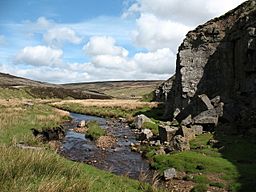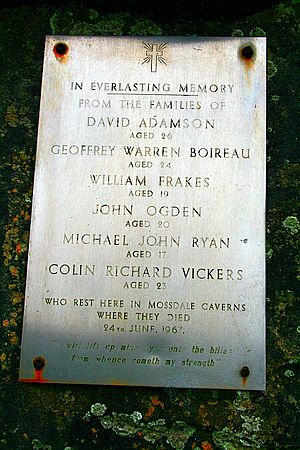Mossdale Caverns facts for kids
Quick facts for kids Mossdale Caverns |
|
|---|---|

Mossdale Scar
|
|
| Location | Yorkshire Dales |
| Depth | 76 m (249 ft) |
| Length | 10.5 km (6.5 mi) |
| Discovery | 1941 |
| Geology | Carboniferous limestone |
| Entrances | 1 |
| Difficulty | Grade 5 |
| Hazards | Flooding |
| Access | not granted |
| Cave survey | Online ULSA survey |
Mossdale Caverns is a large cave system found in the Yorkshire Dales, England. It's located about 5 kilometers (3 miles) north of Grassington. The cave entrance is at the bottom of Mossdale Scar, where a stream called Mossdale Beck disappears underground. This cave system is known for being very challenging and prone to sudden floods.
The caves are formed in a type of rock called Carboniferous limestone. The stream that flows into Mossdale Caverns eventually comes out at Black Keld, about 4.4 kilometers (2.7 miles) away.
Exploring Mossdale Caverns
Exploring Mossdale Caverns began in 1941. A famous caver named Bob Leakey from the British Speleological Association was one of the first to explore it. This cave system is very difficult because it can flood quickly. Many parts of the cave involve long crawls through wet passages. Other sections have water that can be neck-deep.
Bob Leakey often explored these caves by himself. Few other cavers at the time had the strength and endurance needed. The very end of the cave was finally reached again in 1964 by Mike Boon and Pete Livesey. A trip to the far end and back can take between eight and ten hours.
Today, permission to enter Mossdale Caverns is not usually given. This is because of a sad event that happened there in 1967. However, some unofficial exploration still takes place. Cavers believe this system might lead to even larger caves hidden deeper underground.
The 1967 Tragedy at Mossdale
Mossdale Caverns is well-known among cavers in the United Kingdom because of a tragic event. This happened on June 24, 1967. On that day, ten cavers went into the cave system.
About three hours later, four of the cavers decided to leave. When one of them returned to the entrance, she found it completely underwater. Heavy rainfall had caused Mossdale Beck to swell and flood the cave entrance. She quickly realized that the six cavers still inside were in great danger. She ran 4 kilometers (2.5 miles) across the moor to get help.
Cave Rescue teams arrived quickly. However, the high water levels made it impossible to enter the cave. The rescue teams had to dig a trench to redirect the water away from the entrance. Even then, the water inside the cave was too high for a rescue to begin.
Entry into the cave was finally possible the next day. The rescue teams found five of the cavers in a section called the Far Marathon Crawls. Bob Leakey led a search party to another area, hoping the sixth caver might have survived, but they were unsuccessful. The sixth caver was found the following day.
After this sad event, the authorities decided to seal the cave entrance with concrete. This was done to prevent future accidents. Later, in 1971, the cave was reopened. With their families' agreement, the cavers' colleagues carefully buried them in a chamber deep inside the cave system. This chamber is known as "Mud Caverns."
This incident remains the most serious accident in British caving history. A special plaque is placed on the cliff above the entrance to remember those who were lost. There is also a memorial cairn on the moors above the cave. The plaque on the cairn reads: Mossdale memorial cairn – over the place in the cave where the bodies were found.


